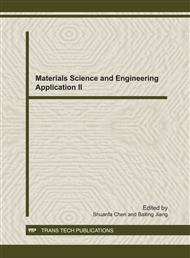p.399
p.404
p.410
p.414
p.420
p.426
p.432
p.439
p.444
Investigation of Microstructure and Machinable Mechanism of the B4C/BN Composites Fabricated by Hot-Pressing Process
Abstract:
The B4C/BN composites were fabricated by hot-pressing process. The B4C/BN composites included the B4C/BN microcomposites and the B4C/BN nanocomposites. The B4C/BN microcomposites were fabricated by hot-pressing process, and the B4C/BN nanocomposites were fabricated by chemical reaction and hot-pressing process. In this research, the phase composition, microstructure, machinability and machinable mechanism of the B4C/BN microcomposites and the B4C/BN nanocomposites were investigated. The microstructure of the B4C/BN composites was investigated by SEM and TEM. The SEM micrographs showed that the B4C/BN microcomposites and the B4C/BN nanocomposites exhibited the homogenous and compact microstructure, and the h-BN particles were homogenously distributed in the B4C matrix. The TEM micrographs of the B4C/BN composites showed that there existed the weak interface between B4C matrix grains and h-BN particles as well as the microcracks within the laminate structured h-BN particles. The machinability of the B4C/BN microcomposites and the B4C/BN nanocomposites increased gradually with the increase of h-BN content. The drilling rates and materials removal rates of the B4C/BN composites increased gradually with the increase of h-BN content. The surface roughness of drilled specimens of the B4C/BN composites decreased gradually with the increase of h-BN content. The relationship between the microstructure and machinable mechanism of the B4C/BN composites was analyzed and discussed. The phase composition and microstructure of drilled debris of drilled specimens of the B4C/BN composites were investigated by XRD and TEM. The microstructure of drilled surface of drilled specimens of the B4C/BN composites was observed and analyzed by SEM.
Info:
Periodical:
Pages:
420-425
Citation:
Online since:
December 2011
Authors:
Price:
Сopyright:
© 2012 Trans Tech Publications Ltd. All Rights Reserved
Share:
Citation:


